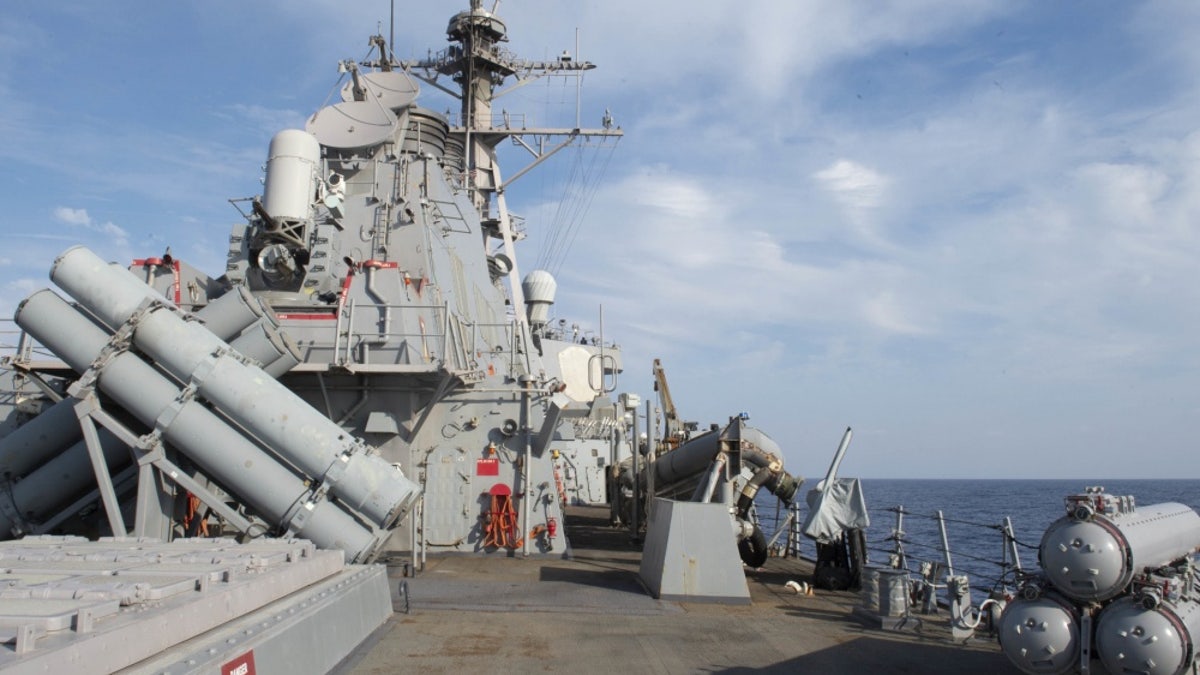Fox News Flash top headlines for January 3
Fox News Flash top headlines are here. Check out what's clicking on Foxnews.com.
Attacking enemy cruise missiles, fighter jets, helicopters and longer-range high altitude ballistic missiles all present substantial threats to Navy surface ships, especially when multiple attacks arrive simultaneously. By and large, defending against incoming ballistic missiles and air and cruise missiles requires separate defensive systems … until now.
A new family of SPY-6 radar systems is being quickly expanded by the U.S. Navy to incorporate a much wider swath of the fleet. The strongest, longest-range and most sensitive variant of the SPY-6, the v1, is the one that has now been built into the Navy’s first-of-its-kind DDG 51 Flight III next-generation destroyer, the future USS Jack H. Lucas; a report from Naval Sea Systems Command says two of four AMDR (Air and Missile Defense Radar) arrays have now been installed in the deckhouse of the Jack H. Lucas.
"Concurrent to these efforts the Navy also recently accepted and installed a new AMDR array for land-based testing of the Flight III combat system," the Navy report said.
Differently scaled variants of the new radar are now being integrated across the Navy fleet, tailored to the specific mission scope of a particular platform. Scott Spence, SPY 6 director at Raytheon, explained that the AN/SPY-6 is the first truly scalable radar, built with radar building blocks – Radar Modular Assemblies (RMA) – that can be grouped to form any size radar aperture, either smaller or larger than currently fielded radars. RMAs, 2-foot by 2-foot by 2-foot blocks, can be configured for different ships and tailored for a particular mission scope, enabling different SPY-6 variants to perform high-value air defenses across the Navy fleet. Carriers and amphibs, for example, need different kinds of air surveillance and defense when compared with destroyers, for example, which need the most capable air and missile defense radar systems.
NAVY ELECTRONIC WARFARE STOPS MULTIPLE ENEMY MISSILE ATTACKS AT ONCE
The concept is to avoid a need to build a new radar system but instead enhance and adjust to the support system that already exists on the SPY-6.

The Arleigh Burke-class guided-missile destroyer USS Arleigh Burke (DDG 51) transits the Mediterranean Sea Oct. 7, 2018 - file photo. (U.S. Navy photo by Mass Communication Specialist 2nd Class Justin Yarborough/Released)
The SPY-6 family of radars is being engineered to be easily repairable with replaceable parts, fewer circuit boards and cheaper components than previous radars. The AMDR is designed to rely heavily on software innovations, something that reduces the need for different spare parts. The Navy has finished one of four planned software builds for the AMDR system.
"Much of the SPY-6 system’s technologies, command logic and software are scalable. This scalability could allow for new instantiations, such as back-fit on existing DDG 51 destroyers and installation on aircraft carriers, amphibious warfare ships, frigates, or the Littoral Combat Ship and DDG 1000 classes, without significant radar development costs," according to Raytheon officials.
This scalability is of particular relevance when it comes to achieving the requisite power, heat and cooling balance needed to build SPY-6 AMDR systems into newer Flight III DDG 51 destroyers, platforms specifically engineered to generate more on-board power.
NAVY ARMS SEA DRONES FOR OCEAN ATTACK
Earlier in the development of AMDR for Flight III Arleigh Burke-class destroyers, former DDG 51 Program Manager Capt. Mark Vandroff told Warrior about the technical adjustments needed to build and operate new levels of electrical power, voltage and cooling technologies. Vandroff said the Navy was working with industry to build what’s called power conditioning modules to turn the ship’s on-board electrical power into 1000-volt DC power for the SPY-6 radar.
In an interesting essay in 2016, when Vandroff was the program manager, he elaborated upon the technical methods of leveraging and integrating much greater levels of electrical power to accommodate a new generation of radar capability with the SPY-6.
Speaking in a 2016 report from the Center for International and Maritime Security, Vandroff explained, "So when we up the power out of our generators to four megawatts we run into our first physics challenge. When we up the power we have to do one of two things, either increase the voltage or increase the current. At a certain level of current, it becomes difficult and at times unsafe to run a certain amount of current through the kind of wiring we would put on a ship. With what we currently have, if we had to up the power anymore we would be hitting those limits. So we have to up the voltage, which is easily done. We’ve got 4160-volt power on aircraft carriers, on DDG-1000, so we had to implement that for Flight III. There’s a separate 4160 bus for powering the radar, and then we stepped down with transformers for our 450 loads that exist."
CLICK HERE TO GET THE FOX NEWS APP
The AMDR also needed to be equipped with specially configured cooling technology, a circumstance that required the construction of a new 300-ton AC cooling plant to replace the existing 200-ton AC plant, Vandroff told Warrior a few years ago.
-- Kris Osborn is the managing editor of Warrior Maven and the defense editor of The National Interest --





















